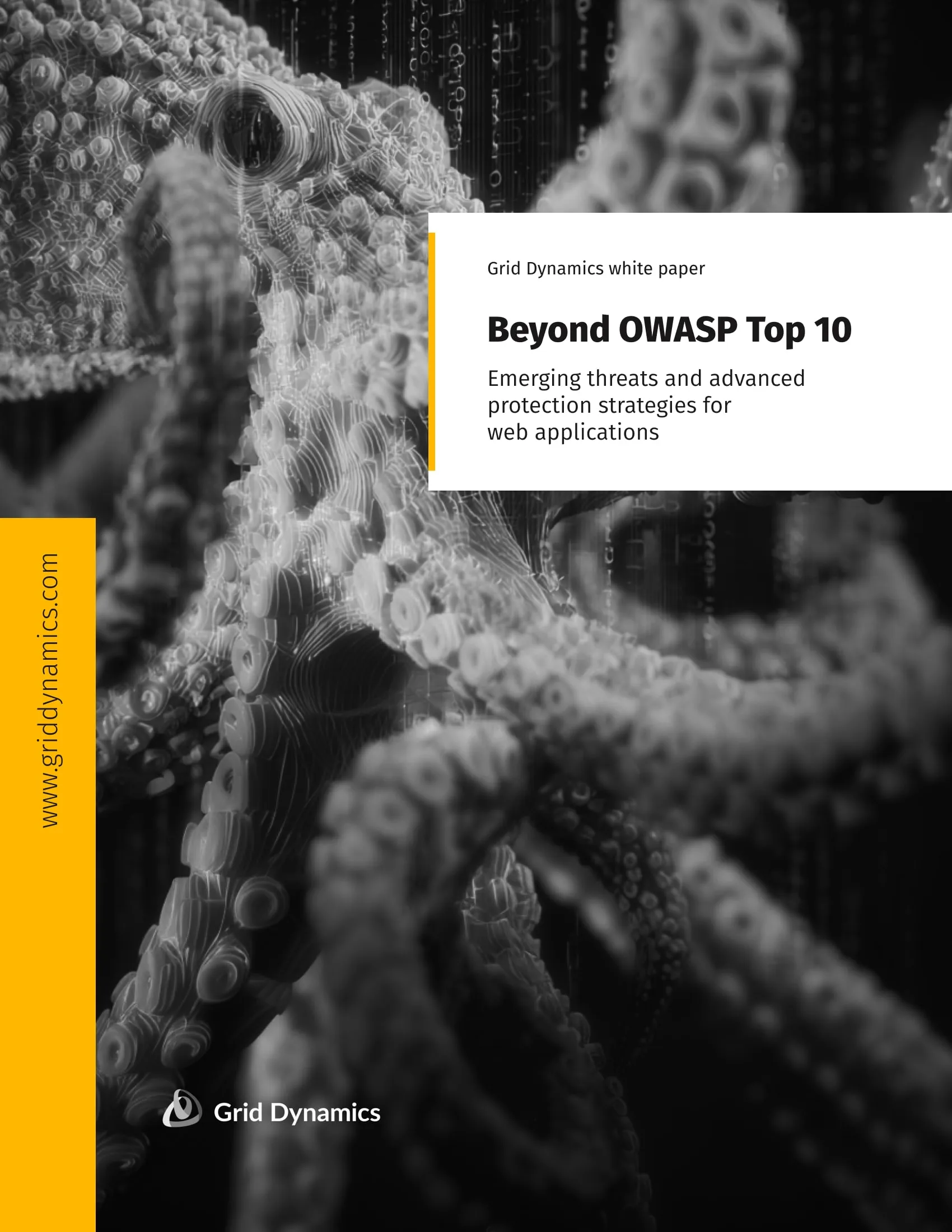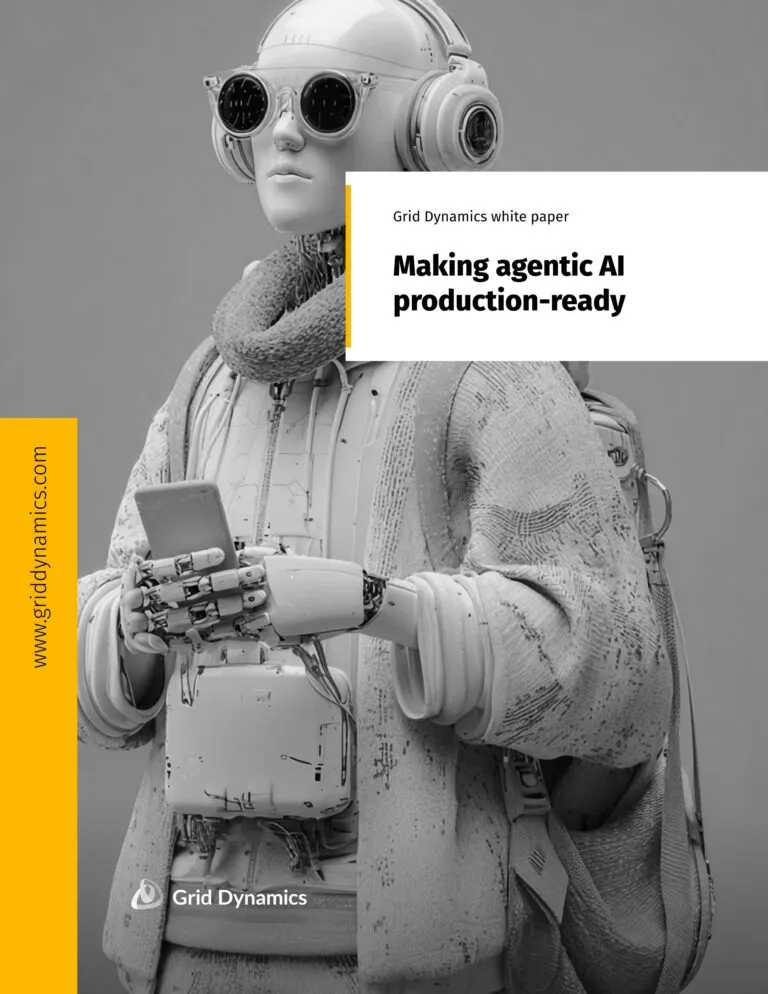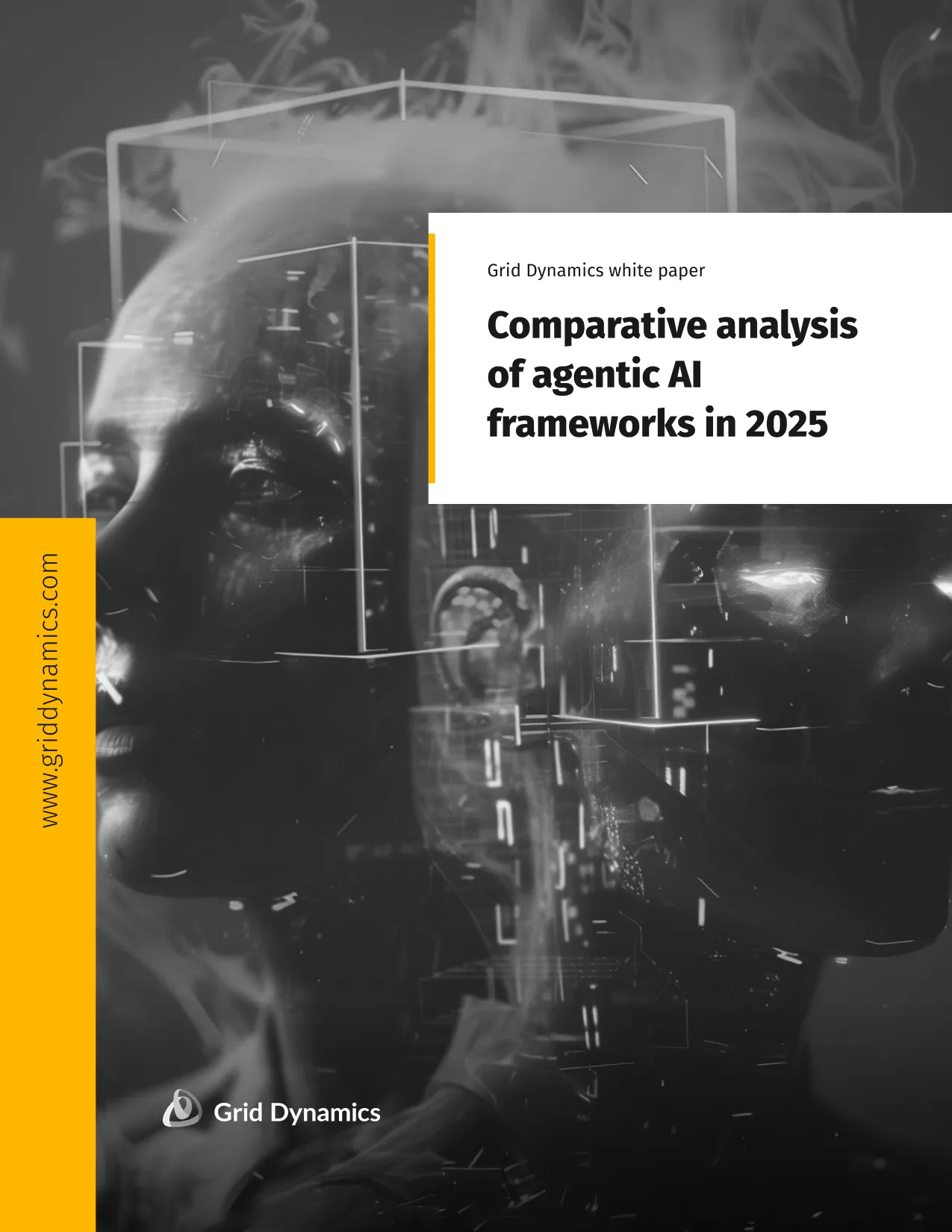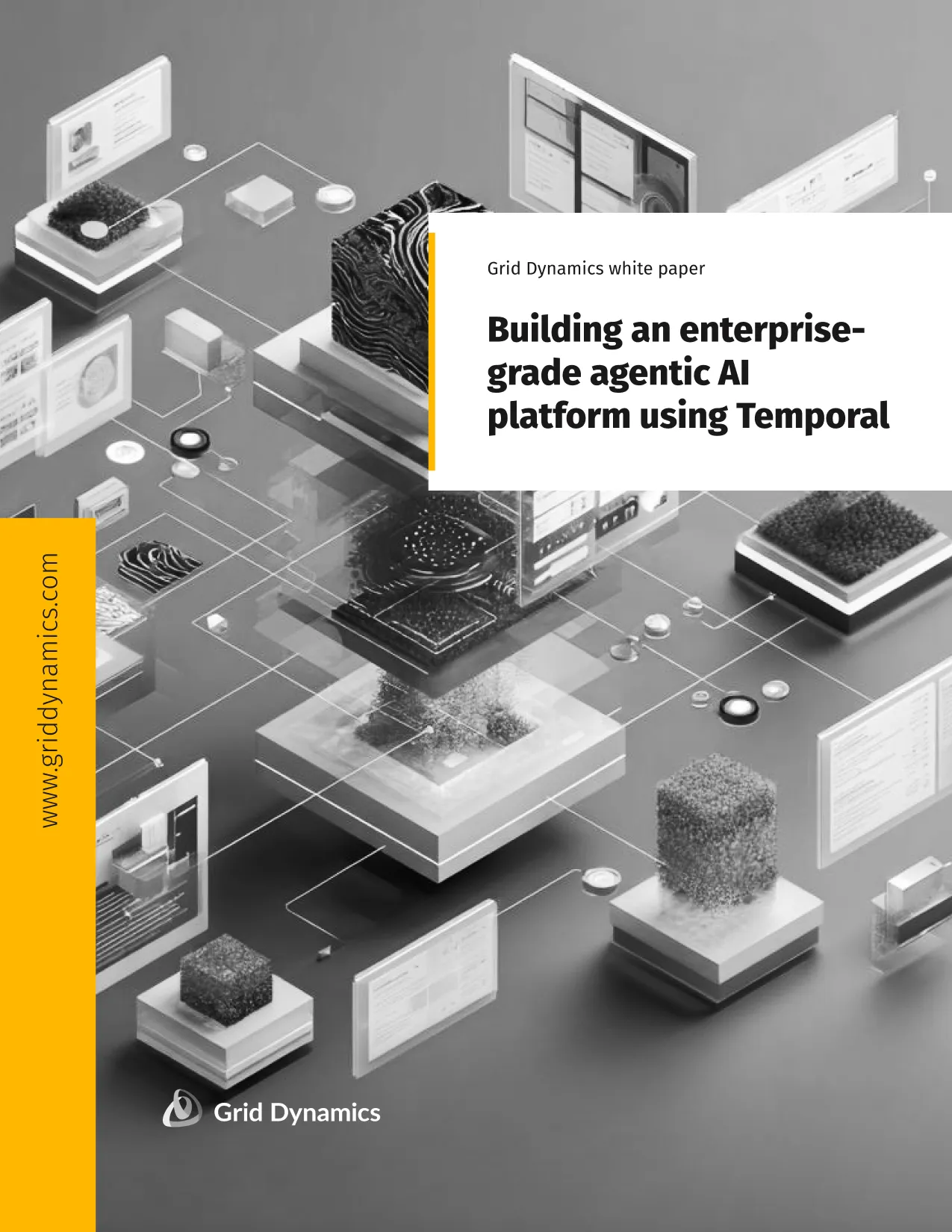Get the White Paper

As an enterprise leader, you’ve likely seen countless AI prototype demos over the last few years promising empty buzzwords like “transformation”, “efficiency”, and “competitive edge”. But how many of those prototypes actually work in production?
40%
of enterprise agentic AI projects are expected to be canceled by 2027
70%
of AI agents fail on real-world multi-step enterprise tasks due to integration issues
62%
of practitioners cite security and authentication as their top challenges when deploying agentic AI
Over the past decade, multiple AI hype cycles have come and gone because the gap between an impressive prototype and a production-ready system remains wide. The core challenges of enterprise deployment (observability, integration, governance, and security) have stayed remarkably consistent. The stakes are higher and the complexity greater for agentic AI deployment, especially when researching, planning, and autonomous task execution capabilities are factored in.
Download our latest white paper to learn how Grid Dynamics is helping leading organizations bridge this gap in agentic AI deployment, turning experimental AI agents into enterprise-ready systems that deliver security, reliability, and scalability across five dimensions:
- AI agent lifecycle management: Managing sprawl, versioning, and safe agentic AI deployments
- Agentic runtime: Ensuring stability, state management, and secure execution
- Enterprise integration: Connecting to diverse systems with unified interfaces
- Observability & evaluation: Tracing decisions and quantifying agent quality
- Governance & security: Controlling behavior and ensuring compliance at scale
Below is a snapshot of each of these domains, with detailed analysis, best practices and actionable techniques in the full white paper.
Skip the read and start planning a PoC
AI agent lifecycle management
Today, building an AI agent is easy. Managing it responsibly across its entire lifecycle is where most enterprises stumble. Without a clear lifecycle strategy, organizations face agent sprawl, untracked versions, and unsafe rollouts that can disrupt business operations and erode trust.
As agentic AI systems evolve from prototypes to production, they must be treated like living systems continuously monitored, optimized, and safely retired. However, most teams still rely on ad hoc processes that fail to account for agents’ stateful, autonomous behavior.
Key challenges enterprises face:
- Agent sprawl: Departments independently deploy duplicate agents without visibility or governance, creating chaos and wasted resources.
- Version chaos: Each agent’s behavior depends on a unique mix of code, model, prompts, and configuration, making changes hard to track and regressions easy to miss.
- Unsafe rollouts: AI agents are stateful systems that run continuously, managing conversations, coordinating workflows, and executing long-running tasks. Killing or redeploying agents mid-operation risks breaking live workflows, and most pipelines aren’t built for persistent, context-aware systems.
Leading enterprises bring order to this agent lifecycle chaos through:
- Central agent registry: Establishing a single source of truth for every deployed agent, complete with purpose, owner, version, status, and access permissions, to ensure discovery, reuse accountability, and revocability.
- Rainbow deploys: Replacing traditional blue-green releases with controlled, side-by-side rollouts that gradually shift traffic and minimize disruptions. Businesses can start with 10% traffic, monitor performance, and then increase traffic incrementally.
- Simulation testing: Move beyond unit tests to large suites of synthetic scenarios to evaluate quality metrics, task success rates, and edge-case handling, along with human-in-the-loop validation to measure task success, quality, and safety before release.
Download the full white paper for proven frameworks, diagrams, and hands-on techniques. You’ll find everything you need to manage, secure, and scale agentic AI across the enterprise.
Enterprise integration
AI agents perform impressively in isolation, but when connected to real enterprise systems like CRM, ERP, or internal knowledge platforms, their limitations quickly show. Integration is where the real issues surface.
Every new system or framework adds complexity, legacy APIs evolve faster than agents can adapt, and human-oriented authentication blocks automation entirely. This results in fragile architectures, inconsistent performance, and growing technical debt that slows innovation.
Key challenges enterprises face:
- Connector complexity: In a typical enterprise, M agents interact with N systems, creating M×N integrations. Five agents talking to twenty systems means a hundred separate connectors to build and maintain. This point-to-point integration complexity creates technical debt that slows productivity and makes the entire system brittle.
- Legacy API brittleness: Nearly 70% of AI agents fail on real-world, multi-step tasks due to integration issues. Legacy systems weren’t designed for autonomous agents and often have poorly documented APIs or none at all, relying instead on UI-only access. Frequent API or schema changes break workflows faster than teams can repair them.
- Authentication hurdles: Agents face security models built for humans—MFA, SSO, CAPTCHA—making automation nearly impossible. Hard-coded credentials expose major security risks, while overprivileged access violates least-privilege principles essential to limit access only to what’s necessary.
How leading enterprises are solving the integration puzzle:
- Model Context Protocol (MCP): A universal USB port for AI agents that standardizes communication between agents and enterprise tools, reducing M×N complexity to M+N simplicity. When an API changes, you update one connector and every agent benefits instantly.
- Agent-to-Agent (A2A) protocol: Enables structured collaboration and task delegation between agents, forming a secure, observable agent mesh that mirrors the reliability of microservice architectures.
- OAuth-style delegated access: Elevates agents to first-class digital identities, a concept known as non-human identities (NHIs) with their own scoped credentials, short-lived tokens, and complete audit trails, ensuring traceability, containment, and security at scale.
Agentic runtime
The agentic runtime is where intelligence meets execution, the layer where agents reason, act, and carry out real work. It’s also where prototypes most often fail when pushed into production. Long-running processes, distributed state, and code execution create new kinds of instability and risk that traditional infrastructure isn’t built to handle.
Key challenges enterprises face:
- Process instability: Unlike typical apps, agents don’t process requests and stop. They run for hours or days, reasoning, looping, and adapting. One lost state or unhandled edge case can crash entire workflows or corrupt context mid-task.
- State management: In multi-agent systems, the distributed state quickly becomes inconsistent. A missed update or failed checkpoint can cascade into downtime, wasted compute, and unreliable automation.
- Unsafe code execution: Agents that generate and run code are powerful but unpredictable. Generated scripts can access unauthorized systems, consume unbounded resources, or compromise the host environment.
How smart enterprises stabilize the agentic runtime:
- Durable execution: Inspired by orchestration engines like Temporal, durable execution frameworks maintain persistent checkpoints, enabling agents to recover from failures. Automatic retries and external state management ensure continuity, while human-in-the-loop approval gates protect high-risk actions.
- Containerized sandboxes: Each agent runs in an isolated, disposable container with strict CPU, memory, and time limits. Pre-execution scans detect unsafe commands, while network access remains locked down to approved endpoints, creating a zero-trust execution environment.
Have an AI use case worth exploring? Ideate, build, and prove ROI to win stakeholder buy-in in hours, not months.
Vibe with Agentic AI CodingObservability
In traditional software, observability means using logs, metrics, and traces to understand what’s happening inside a system. But agentic AI breaks that model. Agents don’t follow predictable logic. They reason, adapt, and collaborate dynamically. Once in production, most organizations discover that standard monitoring tools can’t explain why an agent made a decision, failed a task, or behaved inconsistently.
Key challenges enterprises face:
- Black-box reasoning: Agents generate internal thoughts, plans, and reasoning chains that are invisible by default. Without semantic tracing, teams can’t debug, validate, or explain how outcomes were reached; a serious issue for regulated industries.
- Non-determinism: Identical inputs can yield different yet valid results with AI agents, making traditional testing frameworks fail. Evaluation must shift from verifying processes to ensuring whether agents reach the goal safely and effectively.
- Distributed traces: Multi-agent environments create massive telemetry data across disconnected systems. Without proper context propagation, teams can’t reconstruct end-to-end workflows or identify root causes.
How leading enterprises are redefining observability for agentic AI deployments:
- Semantic tracing with OpenTelemetry: New frameworks capture every prompt, response, and tool invocation, creating a full reasoning trail from goal to outcome. Platforms like Azure AI Foundry, Langfuse, and Maxim AI visualize these traces as digital breadcrumb maps.
- Outcome-first evaluation: Integrated into CI/CD pipelines, this approach measures task completion, accuracy, safety, and efficiency rather than predefined steps. LLM-as-a-judge models and human reviews catch regressions early.
- Cost and latency budgets: Real-time dashboards track token consumption, API utilization, and latency per agent, triggering alerts when daily budgets are exceeded or inefficiencies are detected.
Governance and security
If enterprise integration is the plumbing of agentic AI, governance and security are the guardrails that keep it from going off the rails. Autonomous agents can act without human approval, access sensitive systems, and make irreversible decisions, making traditional security models dangerously inadequate. Without the right controls, they become over-privileged, exploitable, and impossible to audit.
Key challenges enterprises face:
- Over-privileged agents: Autonomous agents often hold broad credentials that allow access to multiple enterprise systems. One compromised key or misconfigured permission can trigger cascading breaches or unauthorized actions, especially in financial and operational domains.
- Direct and indirect prompt injection: Attackers can manipulate an agent’s reasoning through hidden instructions in prompts or poisoned content. These attacks bypass normal validation and can lead to data leaks or harmful actions, without any system knowing it’s under attack.
- No audit trail: Regulated industries demand explainability. Yet most AI systems lack immutable logs to show what happened, why it happened, and who (or what) was responsible. This makes compliance with laws like GDPR, the EU AI Act, and financial audit mandates impossible.
How responsible enterprises are securing agentic AI deployments:
- AI guardrails: Policies written as code automatically evaluate every agent action in real time, deciding to allow, deny, or escalate for human review. Written in Rego, these policies are version-controlled, testable, and fully auditable.
- RBAC & ABAC for non-human identities: Each agent is treated as a first-class digital identity with least-privilege permissions, contextual access controls (such as time, network, or task-bound), and full traceability via enterprise identity and access management systems.
- Immutable decision logs: Every reasoning step, action, and outcome is recorded in tamper-proof append-only logs using cryptographic hashing or distributed ledgers, ensuring decisions remain verifiable and auditable long after execution.
Move from experimentation to enterprise-scale execution
The true test of agentic AI isn’t how fast you can prototype, it’s how confidently you can operate at scale. With the right foundation for orchestration, observability, guardrails, and governance, enterprises can build, monitor, and manage thousands of AI agents with enterprise-grade reliability and control.
Download the white paper to learn how to scale agentic AI deployments with confidence.
Tags
You might also like
Choosing the right agentic AI framework matters. Crew AI, Google ADK, LangGraph, and OpenAI Agents SDK each solve different problems, from rapid multi-agent prototyping to durable, stateful workflows and cloud-native enterprise agentic AI deployments. This comprehensive white paper examine...
Running agent-based systems across your enterprise comes with tough problems. The main ones are keeping costs down, scaling up fast, and making sure nothing breaks when things go wrong. This white paper gets into the real challenges that come up when teams move from simple agent pilots to a ful...

Download this white paper for comprehensive details on how large-scale applications can overcome web application security risks and evolving web threats, including AI-driven attacks, supply chain vulnerabilities, and compliance pitfalls. It goes beyond traditional checklists for web applicati...
From performance and portability to real-world limitations, this white paper explores how WebAssembly (Wasm) is modernizing web development and its growing role in handling AI. Download the full WebAssembly white paper if you’re a frontend and full-stack developer, CTO or technical lead, D...
From retail to manufacturing, and from financial services to healthcare, every industry is eager to capitalize on the potential of artificial intelligence. But AI-ready data is essential to realizing that promise. To truly unlock that potential, AI solutions for enterprises must be built on a fou...
Delivering reliable software at speed is challenging. Even more challenging is continuing to rely on traditional quality assurance as digital transformation accelerates. Manual testing and conventional test automation simply can't keep up with the complexity and pace of modern development. Arti...
Is DeepSeek AI development the right choice for your organization? Download the full white paper to get your hands on comprehensive technical details, in-depth performance benchmarks, and actionable insights from CTOs—for CTOs (and AI innovators). DeepSeek has quickly established itsel...










